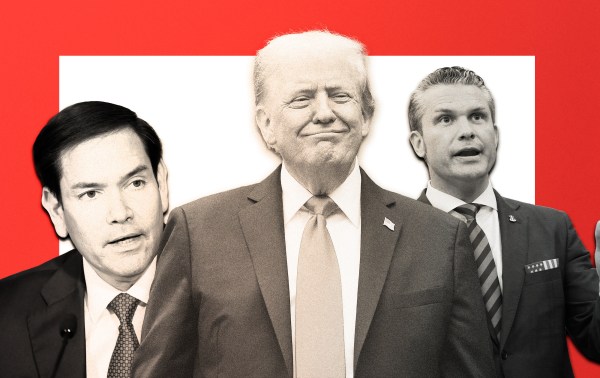In an op-ed for the Washington Post last week, Florida Sen. Marco Rubio outlined why he now believes in industrial policy—done right. “In the past, Republicans outsourced such decisions to ‘the free market,’ which meant some combination of nationless corporations and Communist China,” he wrote. Most of his piece (rightly) criticizes the Biden administration’s foray into industrial policy—meaning government support for favored or strategic industries—through recent laws like the CHIPS Act and the Inflation Reduction Act. Still, besides a few vague references to “supporting critical industries” and relying on “export quotas,” the senator left his preferred alternatives largely up to the imagination.
Rubio’s piece, however, was less notable as a look at the views of a single senator than as a reflection of a much more widespread attitude toward federal power on the right. By now, it should be clear that today’s nationalist right treats it differently than limited-government conservatives traditionally have. Since blue states like California and liberal bastions like Chicago reject their preferred policies, NatCon pundits and politicians alike have concluded that saving America necessitates flexing federal muscle. For them, federal power should be used, not reined in.
Media personalities and think tankers alike have proposed using federal power for a wide array of purposes, from banning pornography to empowering the Department of Labor to “encourage” businesses to observe the Sabbath. Like Rubio, some Republican politicians have proposed enlarging the scope of federal authority. Missouri Sen. Josh Hawley, for example, has put forward legislation empowering officials at the Department of Commerce and the Department of Defense to decide what goods should be subjected to federal regulations requiring companies to meet “made in America” dictates. And of course, candidate Donald Trump would tax the endowments of private universities and even direct the Justice Department to “dismantle every gang, street crew, and drug network in America,” among other examples.
It’s peculiar to see these ideas proposed by the same people who call for cutting federal spending, “draining the swamp,” and getting the feds off Americans’ backs. They seem to think they can reconcile these competing notions by empowering the president to yoke and direct the federal beast more firmly via Schedule F. If it takes a Red Caesar to right the republic, so be it.
But that line of thinking forgets a lesson learned over the past century: Federal policy frequently fails.
In part, our constitutional system’s separation of powers and regular elections discourage us from overrelying on federal authority. When control of the White House shifts from one party to the other, the new chief executive promptly gets to work undoing his predecessor’s efforts. President Joe Biden issued executive orders wiping out former President Donald Trump’s Schedule F and regulatory reform executive order, for example. Establishing lasting federal policies typically necessitates passing statutes through both chambers of Congress, which is seldom held by the same political party as the president.
And even if a president’s party controls Congress, that doesn’t guarantee success. Republicans held the presidency and both chambers of Congress from 2003 to 2007, as George W. Bush expounded a “compassionate conservatism” agenda that accepted big government and confidently deployed it to implement his administration’s policies. It tried to regulate educational standards for all public schools and encourage sexual abstinence among teens. Most notably, the Bush administration also sought to remake Iraq into a free market republic and Afghanistan into a stable nation. None of these efforts were particularly successful, and the wars were especially costly.
What right-leaning advocates of a bigger government overlooked then and now is that federal policymaking is an inherently fraught enterprise. So many things can go wrong even when you have the smartest people with the best intentions in the room. One need only look at the Casa Grande Farm experiment, which the conservative luminary Edward C. Banfield described in his brilliant 1951 book Government Project, which I republished late last year.
In 1937, a combination of Dust Bowl-era weather, collapsing food prices during the Great Depression, and the rise of mechanized mega-farms displacing family farms produced a migrant crisis. To respond, President Franklin Roosevelt issued an executive order establishing the Farm Security Administration (FSA) to propose solutions for rural poverty.
Rexford Tugwell, a Columbia University economist who headed the FSA, struck upon the idea of having the government give farmers a home and land to farm. The FSA bought up a few thousand acres of land in Pinal County, Arizona, and began constructing roads and homes. Then Tugwell and his aides reconsidered: Creating small farms was a risky endeavor, after all. Poor weather and competition from the big new corporate farms could quickly wipe these farms out. Thus, the FSA decided to pool individual farms into a giant cooperative farm where all the settlers could work together.
Though some members of Congress, who were little consulted, thought Casa Grande looked like Soviet collectivism, to Tugwell and his team the plan looked smart and sensible. The FSA would recruit 60 families with farming experience, house them, and help them get their farms started. Each Casa Grande farmer would be paid a steady wage for working and also own a share of the farm. The farm’s revenues would reimburse the government for its costs, and eventually the farmers would own the enterprise outright.
Between 1937 and 1942, Casa Grande bloomed. The farms produced alfalfa, cotton, grain, cattle, hogs, chickens, and sheep for markets as far away as Los Angeles. In today’s dollars, Casa Grande’s assets were valued at more than $4 million, and its annual profit reached nearly $500,000. The settlers’ equity in the project was about $1 million. When Banfield visited Casa Grande in 1943, it seemed as though the farmer’s lives had been transformed for the better.
Yet, in 1944 Casa Grande Valley Farms entered legal liquidation, and the farms’ settlers left the project. Some of them walked away with sufficient funds in their pocket to acquire their own land—but many settlers did not. Those less fortunate returned to living as poor, migrant farm workers.
Casa Grande collapsed, Government Project explains, because its residents could not “cooperate because they were involved in a ceaseless struggle for power.” Despite their immensely improved material conditions, they feuded with the FSA officials and one another over the farm’s operations. FSA administrators had not anticipated that the settlers would break into factions, or that they would squabble with one another over who got assigned to do what work.
Nor did the bureaucrats understand the inherent conceptual tensions of the project. Was the objective to alleviate poverty by having the settlers earn a steady wage? Or was it to operate an efficient, profitable farm, which necessitated controlling operational costs and seeking efficiencies by replacing human labor with mechanization? Was the FSA willing to let the settlers run the farm even if they made errors or was the FSA to keep a steady hand and protect taxpayers’ investment?
Much to the astonishment of Tugwell and company, when given the choice to buy the farm and preserve their equity and materially richer way of life, Casa Grande’s settlers instead voted to abolish the government project.
The Casa Grande project cannot be waved away as a random boondoggle. Government Project reminds us that federal policymaking by nature almost always is centralized planning. People in Washington decide that something should be done, and then coordinate a lot of bureaucrats, state and local officials, and the policy’s beneficiaries to dutifully follow their plan. Federal policymaking presumes policymakers have all the information they need, that the plan is sound, and that everyone involved has a shared understanding of the plan and their role in it. Those are big assumptions, and rarely do they hold.
There is a corpus of case studies, policy histories, and social scientific literature that show the myriad ways policymaking goes awry. Policymakers often disagree over how to solve problems, and the bargains they cut may impart conflicting objectives. Conceptual flaws and officials’ hesitance to end programs means public policies frequently have more long-run costs than benefits. Studies of bureaucracies illustrate that agencies develop their own interests that may diverge from the public interest, that they can be captured by special interests and form corrupt iron triangles with legislators. Almost inevitably, federal programs spawn new classes of beneficiaries who set up shop permanently in Washington to ensure their preferred policies endure.
Tugwell, who wrote an introduction for Government Project, observed that in the failure of Casa Grande farm “We can see in it many lessons if we will.” Conservatives seeking to deploy the federal government to do more things would be wise to revisit those lessons.
Not least, they should keep in mind that unilateral executive action invites congressional retribution from the other party. Congress used its power of the purse to zero out the FSA’s authority to spend money on the Casa Grande project. Conservatives also should understand the difficulties of using federal power to create high-quality jobs. Tugwell thought he could create a government farm that could pay workers well; unable to reduce labor costs, the farm was sure to be wiped out by private competitors eventually. And critically, conservatives need to remember that successful use of federal power presupposes both that federal authorities fully understand the problem and that their remedy will be embraced by those charged with its implementation. The FSA failed to understand the nuances of managing a large farm and errantly assumed the people working it would eagerly cooperate.
Above all, the failure of the Casa Grande experiment should serve as a reminder that policymakers are wise to be skeptical about using federal power. If anything can go wrong, it probably will.






Please note that we at The Dispatch hold ourselves, our work, and our commenters to a higher standard than other places on the internet. We welcome comments that foster genuine debate or discussion—including comments critical of us or our work—but responses that include ad hominem attacks on fellow Dispatch members or are intended to stoke fear and anger may be moderated.
With your membership, you only have the ability to comment on The Morning Dispatch articles. Consider upgrading to join the conversation everywhere.